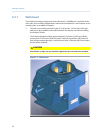
3.3 Gas chromatograph wiring
3.3.1 Power source wiring
Follow these precautions when installing power source wiring:
• All wiring, as well as circuit breaker or power disconnect switch locations, must
conform to the CEC or NEC; all local, state, or other jurisdictions; and company
standards and practices.
• Provide single-phase, three-wire power at 120 or 240 VAC, 50-60 Hertz.
Note
If you do not have a single phase, three-wire AC power source, you must purchase an isolation
transformer. Refer to Drawing #CE19492E1 at the back of the manual for more information.
• Locate in a safe area.
• Provide the GC and any optionally installed devices with one 15-amp circuit breaker
for protection.
CAUTION!
15 amps is the maximum current for 14 AWG (wire).
• Ensure that the 24 VDC input power is compliant with the Separated Extra-Low
Voltage (SELV) standard by suitable electrical separation from other circuits.
• Use multi-stranded copper conductor wire according to the following
recommendations:
- For power feed distances up to 250 feet (76 meters), use 14 AWG (American
Wire Gauge) (18 Metric Wire Gauge), stranded.
- For power feed distances 250 to 500 feet (76 to 152 meters), use 12 AWG (25
Metric Wire Gauge), stranded.
- For power feed distances 500 to 1000 feet (152 to 305 meters), use 10 AWG (30
Metric Wire Gauge), stranded.
- Cable entries are M32 in accordance with ISO 965.
3.3.2 Signal wiring
Follow these general precautions for field wiring digital and analog input/output (I/O)
lines:
• Metal conduit or cable (according to local code) used for process signal wiring must
be grounded at conduit support points because intermittent grounding helps
prevent the induction of magnetic loops between the conduit and cable shielding.
Installation and setup
3
Installation and setup
33


















